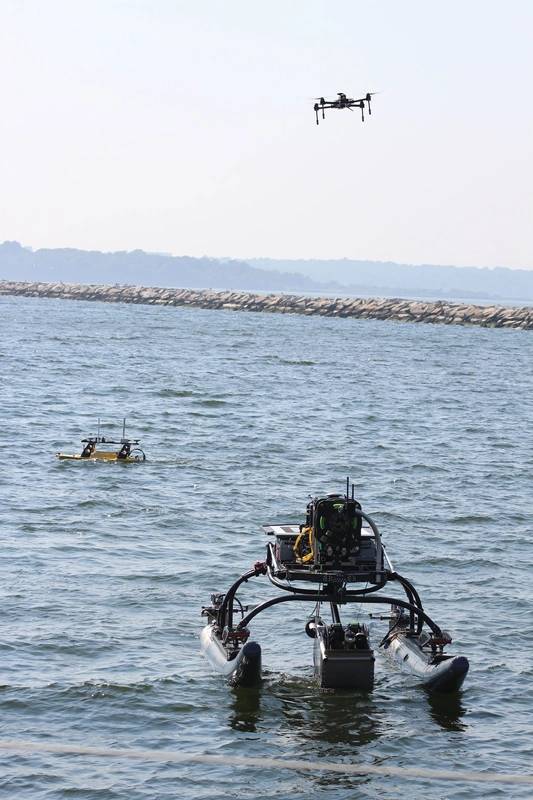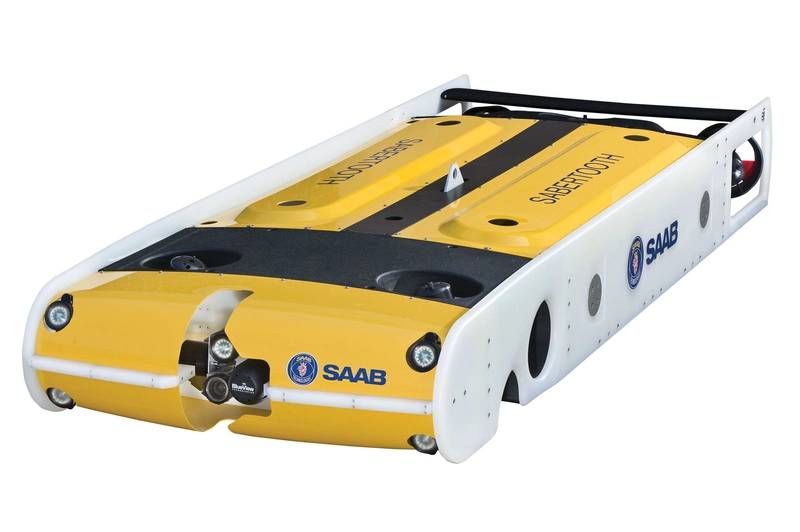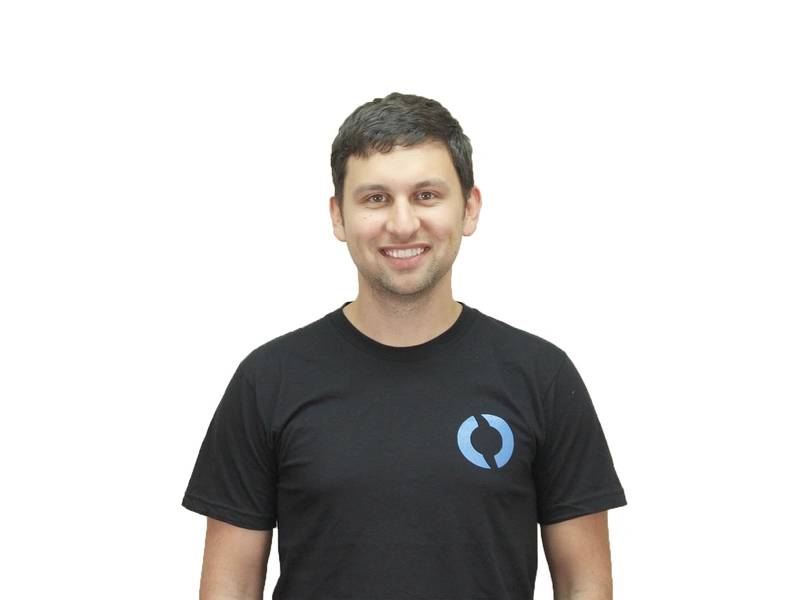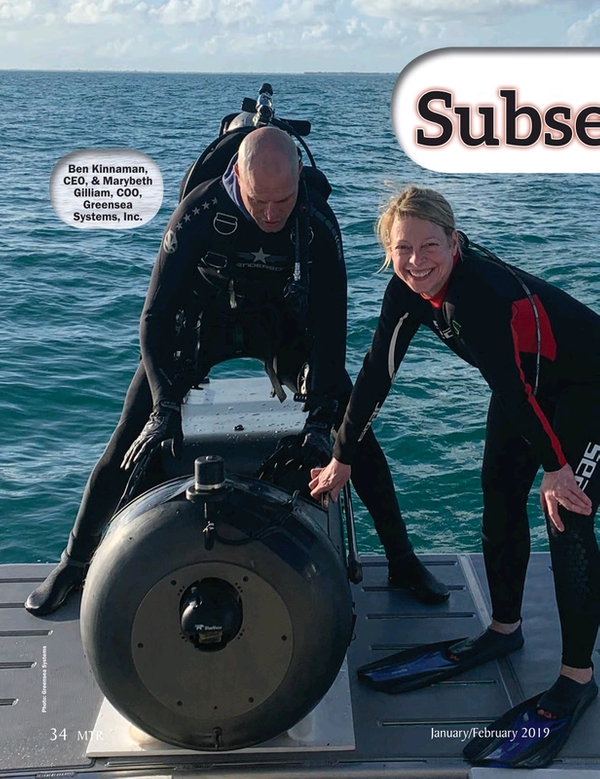
Subsea: The Future of Unmanned Vehicles
Subsea vehicles of every shape and size have evolved mightily in the past few years, as a confluence of communication, electronic and autonomy technologies have conspired to increase the accuracy, duration and efficiency of such systems. MTR tapped a few key industry leaders to discuss the path ahead.
“I think there are two current market drivers forcing the industry to develop and adopt technologies that make subsea vehicles more efficient and effective,” said Ben Kinnaman, CEO, Greensea Systems, Inc. “First, the market really wants to use miniature vehicles and realize the long-promised potential of these systems. Second, we need to get more value from our human operators.”
Kinnaman has a unique perspective as Greensea Systems Inc., which he founded in 2006, is a leader in navigation and vehicle control technology and is the creator of OPENSEA, an open architecture software framework for marine robotics across various vehicle sectors.
“We develop software and hardware that revolutionizes the working relationship between people and machines both on and under the surface of the ocean,” said Kinnaman, who, like many in the sector “started working with vehicles as an ROV pilot after leaving a diving career. Now I am focused on what vehicles could be for the next generation of the subsea industry.”
Kinnaman has been a leading voice in aiming to change what he perceives as the industry’s ‘bolt-on’ mentality. “Sensor and vehicle manufacturers are selling the dream and the market is buying, but, the old model of technology adoption where we just buy a new sensor and strap it on to an existing system is not going to work,” Kinnaman said. “To realize this potential and fulfill what the market is expecting requires the industry to figure out technology solutions for making these systems truly efficient and effective in the hands of the operator. Full integration and task efficiency is the only real path forward for these systems. We have to address how to deliver a system that does what the operator intends it to do, easily.”
AUVs
“Two years ago I attended a workshop at Rice University moderated by the Subsea Systems Institute where major oil & gas companies, their providers, and underwater vehicle manufactures spent the day generating a development strategy for AUVs for subsea applications,” said Bob Melvin, the Vice President of Engineering at Teledyne Marine Systems. “Their number one requests was to make underwater systems that can perform subsea tasks. To reach this goal there is acknowledgement that the commercial sector will need to leverage advances made in the defense sector. But for this to become reality, operators need to be able to trust the AUV will complete its mission and return with useable data, or take an alternate action.”
 Image: Teledyne Marine Systems
Image: Teledyne Marine Systems
Melvin is a long-tenured industry executive. For the past 10 years he has been responsible for overseeing engineering for Teledyne’s autonomous vehicles which includes the Gavia AUVs, the Slocum glider, and recently the SeaBotix ROVs and Oceanscience USVs. Previous to Teledyne, he was the engineering manager at Hydroid where he was also the program manager working with the U.S. Navy EOD team developing the Swordfish version of the REMUS-100.
Energy density and availability is the number one market driver in today’s AUV market according to Graham Lester, Senior Vice President, Sales & Marketing, Hydroid. “Customers are looking for improved energy sources to allow for greater endurance and larger payload sensors. Additionally, they are looking for improved underwater positioning and through-water communications. The desire is to move toward providing a sustained presence where we can, not only, sense the environment but can affect it and react to it.”
Lester has more than 30 years of experience with military, oceanographic, offshore and hydrographic equipment, including a detailed understanding of underwater vehicles and their applications. He oversees Hydroid’s U.S. and international sales and marketing teams, as well as customer service and training. Additionally, he collaborates with other Kongsberg entities to develop growth strategies in the Marine Robotics market.
While technical solutions are obvious points of research and work, overall affordability of systems could be the real growth driver that ultimately makes the AUV market more mainstream.
 “Riptide is working with numerous undersea sensor providers to bring new capabilities forward to the market affordably and efficiently. The micro-UUV offers a great deal of flexibility for the payloads it can field, and it has been built in dozens of configurations. With a depth limit of 300m and a standard endurance of over 30 hours on alkaline batteries, it is an extremely capable platform. Riptide is currently in the process of fabricating their first series of deeper rated micro-UUVs. Stay tuned for more from this innovative micro-UUV developer.” Jeffrey M. Smith, President, Riptide Autonomous Solutions
“Riptide is working with numerous undersea sensor providers to bring new capabilities forward to the market affordably and efficiently. The micro-UUV offers a great deal of flexibility for the payloads it can field, and it has been built in dozens of configurations. With a depth limit of 300m and a standard endurance of over 30 hours on alkaline batteries, it is an extremely capable platform. Riptide is currently in the process of fabricating their first series of deeper rated micro-UUVs. Stay tuned for more from this innovative micro-UUV developer.” Jeffrey M. Smith, President, Riptide Autonomous Solutions
“Riptide is working with numerous undersea sensor providers to bring new capabilities forward to the market affordably and efficiently,” said Jeffrey M. Smith, President, Riptide Autonomous Solutions. “The micro-UUV offers a great deal of flexibility for the payloads it can field, and it has been built in dozens of configurations. With a depth limit of 300m and a standard endurance of over 30 hours on alkaline batteries, it is an extremely capable platform. Riptide is currently in the process of fabricating its first series of deeper rated micro-UUVs.”
Riptide Autonomous Solutions entered the AUV market as a disruptor in the small autonomous undersea vehicle space. In 2018, it released the MkII micro-UUV into full production. The MkII micro-UUV was a significant design leap forward for Riptide and incorporated molded instead of previously 3D printed components and a major electronics evolution. Riptide’s MkII electronics boards dropped the vehicle’s hotel power to 3.8 Watts, providing more power for payloads and greater vehicle endurance. With this electronics update, its was also able to significantly reduce internal wiring, simplifying the design, increasing its robustness and making the vehicle more operator friendly.
ROVs
The ROV side of the vehicle equation is more mature than AUVs, and it too is evolving to take advantage of emerging technology trends. The fact that an ROV is tethered is both a strength and a weakness, the tether carrying and allowing significantly more power, but also limiting its range and maneuverability.
Since its founding in 1986 Saab Seaeye has pioneered innovations that have helped to transform the underwater robotics industry, including brushless DC thrusters, efficient high-frequency power distribution, intelligent distributed control systems and the use of plastics and composites in vehicle construction, said Matt Bates, Director, Saab Seaeye Ltd.
 Saab Seaeye Sabertooth. A hybrid resource that offers autonomous and seabed resident capabilities. Image: Saab Seaeye
Saab Seaeye Sabertooth. A hybrid resource that offers autonomous and seabed resident capabilities. Image: Saab Seaeye
Bates’ career has been involved with underwater systems. “After graduating with an Honors Degree in Engineering Systems I began working on underwater systems in the defense industry,” said Bates. “It was 25 years ago that I joined Seaeye as Head of Electronics since when I have held various technical and management posts and am now Director of Sales and Marketing.”
On the ROV side, Bates said “operational cost effectiveness and safety are by far the key market drivers. To achieve this, markets are looking for the best possible system solutions at the lowest possible real cost by seeking UUV systems that satisfy four central tenets: safety; vehicle capability; reliability; and the use of smart technologies.
Blue Robotics’ is disruptor in the ROV space, its mission to make low-cost, high-quality components and vehicles to make marine robotics more accessible. “We started with a Kickstarter campaign in 2014 for the T100, an underwater thruster, and have since launched over 200 enabling products including the BlueROV2 remotely operated underwater vehicle,” said Rustom ‘Rusty’ Jehangir, Founder and CEO, Blue Robotics. “Today, we have a team of 30 people in Torrance, CA, where we’re designing our products, manufacturing them, and shipping them to thousands of customers around the world.”
Interestingly, Jehangir’s background is in aerospace engineering and drones. “I’d never made anything related to subsea prior to starting Blue Robotics,” he said. “That’s led to a steep learning curve but a fresh (and perhaps sometimes naive) approach to what we’re doing.”
“On the technology side of things, I think things are being pushed forward through the adoption of technology from other industries and bringing it to the subsea space,” said Jehangir. “For instance, our company is leveraging a lot of technology, electronics, and software that was developed for the drone industry. By leveraging that technology, we’re able to offer capabilities that are years ahead of the status quo but at a lower price. I think we will continue to see that across the industry.”
 Rustom Jehangir, Founder and CEO, Blue Robotics
Rustom Jehangir, Founder and CEO, Blue Robotics
“I feel that the low-cost and open products on the market from companies like Blue Robotics, OpenROV, Riptide AS, and others have made a big step towards making UUVs mainstream,” said Jehangir.
Regardless of technology deployed, Bates of Saab Seaeye contends that the ability to address the widest range of underwater tasks opens up the possibility of achieving more across more markets which, along with the general safety drive to reduce manned diving intervention, continues to increase the use of UUVs, said Bates. “The demand to achieve more tasks using the most compact robotic solution possible, comes from a drive to reduce deck space and vessel size and reduce mobilization time and costs, while at the same time being able to work in stronger currents or deeper waters, which comes naturally from compact, more efficient solutions.”
There are more market drivers and use scenarios than there are vehicles, and there is no ‘silver bullet,’ no ‘one-size-fits-all’ solution. “The various different market segments have some quite specific needs and environments to consider. For example, the high current shallow water nature of renewables installation and IRM work differs from deep water oil and gas construction and intervention applications. Also, nuclear decommissioning activities demand different tasks to be completed, compared to aquaculture or marine science applications - and of course their environments are very different. The market demands a wide range of platforms and a high degree of customization for the specific sector needs.
In this regard Bates counts Saab Seaeye’s iCON ecosystem of intelligent robotic building blocks and the development of the Sabertooth hybrid vehicle platform with its autonomous and seabed resident capabilities as good examples of products and capabilities developed specifically to both enable and address these key market demands.
The Path Ahead
While there are obvious differences between AUVs and ROVs, some like Kinnaman of Greensea see the lines of differentiation blurring, particular as autonomy evolves.
“Autonomy and integration technologies are the main (technology) drivers,” said Kinnaman. “Autonomous technologies in ROV systems are driving us to reconsider how we crew offshore operations, enabling plans involving resident systems, and opening the option of keeping crews on the beach versus offshore. Autonomous technologies are also enabling the adoption of subsea vehicles and marine robotic systems by a much broader user group: EOD technicians, Special Operations Forces, first responders, and ship husbandry service providers to name just a few.”
But it’s not just autonomy in and of itself, rather how that autonomy is built into the bigger picture system, whether its and AUV, ROV or UUV, and including the human element, too.
“The role of autonomy in UUVs is without a doubt the most significant advance in our industry from my perspective,” said Kinnaman. “Not just the emergence and capability of autonomy, but how we consider, use, and deploy autonomy and autonomous technologies is really important to where we are and where we are going as an industry. We are moving autonomous technologies into vehicles that have always been “remotely operated” or even manned to realize more efficiency and capability. We are really blurring the lines between “ROV” and “AUV” and minimizing the technical difference between manned and unmanned. Autonomy lets us realize smarter more capable vehicles that we can work with in a variety of capacities, whether we supervise them or not. This shift in thought is making UUVs more mainstream because you don’t need to be an “ROV operator” or engineer to use them.”
And while much of the attention inevitably shifts to the machines and the technology onboard, Kinnaman is adamant to remember the human element of the man/machine interface.
“The second market driver pushing us to make vehicles more efficient and effective focuses on getting more value from our operators,” said Kinnaman. “Our traditional model of working with vehicles was based on a vehicle operations team, pilots and technicians, and subject matter experts (SMEs). As we look to control costs, we are considering reducing the amount of personnel required for vehicle operations and getting more out of a smaller team. So, do we train ROV pilots and technicians to be SMEs or do we train SMEs to be ROV pilots? Or, do we build better vehicles that do not require on-site technicians and that can fly themselves with high-level, task-based, instruction from SMEs? “
“I think ultimate efficiency and effectiveness is offered in the latter, with autonomous technologies playing a more vital role in ROV operations. Having greater autonomy within ROVs will also allow a broader user group composed of operators, who do not have specific training as pilots and technicians, to adopt subsea vehicles as tools to do work in and on the ocean.”
Read Subsea: The Future of Unmanned Vehicles in Pdf, Flash or Html5 edition of January 2019 Marine Technology
Other stories from January 2019 issue
Content
- Subsea Electrification: Subsea Power Evolves page: 16
- Contemporary UUV Propulsor Design page: 20
- Unmanned Vehicles: 25 Years of Milestones page: 26
- Subsea: The Future of Unmanned Vehicles page: 34
- The “Disruption” in AUV Trends page: 42


